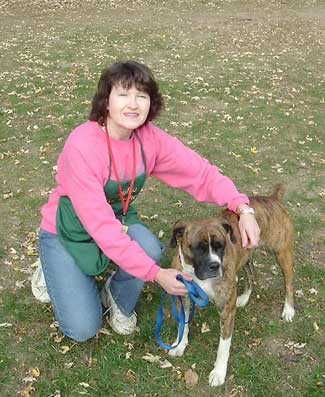When Sylvia Bowman wanted to adopt a dog from the Humane Society of Huron Valley (HSHV) in 2000, she saw that dogs enjoyed being walked outside, even if they were not chosen for adoption.

Seeing the benefits of HSHV’s dog-walking and cat-cuddling program was enough to convince her to become a volunteer for the organization.
“It’s just something big when you see a dog come in that’s so scared and then you see them going home with the family,” Bowman says. “They’ve come through and they’ve had another chance. And I’ve seen that many times. That’s a good feeling.”
The dog-walking and cat-cuddling program relies on volunteers like Bowman, a human resources assistant in the Dental School, to support the animals during their time at the shelter.
It is a program that allows shelter animals to receive care and attention, exercise and a little bit of freedom while they are kept at the Humane Society. Bowman says the program was developed so the animals can relieve stress.
“You just try to make their stay as comfortable and happy as possible,” Bowman says. “Yeah it’s rough; sometimes if you see a scared little dog, you just get a big fluffy comforter and put it there in the cage, they just seem so much better when they can cuddle. Sometimes you just need to pamper some more than others.”
Bowman walks dogs at the shelter three times a week. In her efforts to draw in more volunteers, Bowman says she always addresses the fact that both cats and dogs need attention.
“I make the fliers and I put them up wherever I go,” Bowman says. “My husband calls me a dog nut. The shelter is always on my mind, and I’m always trying to get the word out that we need more volunteers.”
While there currently are 300 active volunteers, Bowman says there is a high turnover, which may be due to the number of students from U-M and Eastern Michigan University who assist the shelter. Ultimately, she says, more volunteers means more time outside for the dogs. The volunteers take each dog out walking for 20 minutes a day, and when that is accomplished, they can start the cycle over again.
“More time out for them makes them happier,” Bowman says. “They become more adoptable and more owner-socialized.
“[We] just get them away from other dogs for a while. Sometimes they’re scared. Sometimes they just have so much energy you just want to try to get some of that energy out of their bodies,” she adds.
The dog walkers make the most of the area surrounding the HSHV, which includes three acres of wooded land near the University’s Matthaei Botanical Gardens.
Volunteers also participate in other special events to get the word out about the HSHV and the adoptable pets. Bowman has participated in many parades and walks, where shelter dogs wear capes that say, “I’m adoptable.” Bowman says the shelter also has, in the past, worked with the Salvation Army during the holiday season.
Bowman thinks volunteering is rewarding for both dogs and walkers. In this symbiotic relationship, Bowman says she’s gotten more back from the dogs than she gives to them.
“I think about them a lot and I’m just so happy when they are adopted,” Bowman says. “There are times when I think, ‘Oh, I’ll just take this one,’ but my dog does not allow that. She wants to be the queen pet.”
Bowman’s beagle terrier, Snoopy, adopted from the shelter in 2000, may reign supreme in her household, but Bowman says she’s gained an appreciation for all different breeds and mutts since working at the shelter.
“Pit bulls, rottweilers, I love them all.”

